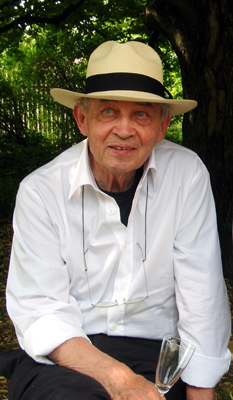Fragen an den Goldschmied Hermann Jünger – Ein Gespräch / Questions for the Goldsmith Hermann Jünger – A Conversation October 2001
The Compendium Finale of Contemporary Jewellers 2008
Darling Publications, Cologne & New York, Andy Lim
Publication March 2009
Excerpt from an interview
J.K.: There is a line from a film by Pier Pasolini: when craft dies, history stops. Can you comment on this?
H.J.: It’s a valid saying, for craft in the best sense remains a passing on of experiences, knowledge of a feeling for subtleties, for feasibility, usability of form. A lack of experience with traditional craftsmanship means a reduction in the appreciation and awareness of quality. If society takes away the ability of craft to survive—it would be a problem. There are still a limited number of people who want handcrafted products and are ready to pay for them. The two are interdependent, of course, and the circle is getting smaller and smaller.
J.K.: At the start of our conversation you spoke about how important antiquity was for you. And this reminded me of when I went to Greece for the first time, a long time ago. I was in Olympia and I saw jewelry there that absolutely fascinated me: the pieces were actually perfect, but they did not aim for perfection, the way jewelry being made today would.
H.J.: Technical and organic perfection strike me as two different things. A steel ball turned and polished to precision can often be endlessly repeated with today’s tools. Each ball will look exactly like all the others—perfection to an extremely high degree. An egg has a shape that hasn’t changed in millennia; eggs are all alike—“to be as like as two eggs” as we say in German—and that too is a perfect shape. But upon closer inspection we discover that, in fact, no two eggs are alike. There are differences in the surfaces, the shades of color, the sizes. In contrast to industrially manufactured things, the egg is something organic, living. It is more than perfection; I see it as something organically perfect, complete. This is why perfection in craft perplexes more than it convinces me. Older craftsmanship is rarely entirely perfect; it was industry that ultimately destabilized craft. Organic irregularities were regarded more and more often as mistakes. The ambition to produce flawless things overshadowed the sense of responsibility to form. Most of today’s craft workshops work with machines that make perfection possible but no longer allow for organic perfection.
The Compendium Finale of Contemporary Jewellers 2008
Darling Publications, Cologne & New York, Andy Lim
Publication March 2009
Excerpt from an interview
J.K.: There is a line from a film by Pier Pasolini: when craft dies, history stops. Can you comment on this?
H.J.: It’s a valid saying, for craft in the best sense remains a passing on of experiences, knowledge of a feeling for subtleties, for feasibility, usability of form. A lack of experience with traditional craftsmanship means a reduction in the appreciation and awareness of quality. If society takes away the ability of craft to survive—it would be a problem. There are still a limited number of people who want handcrafted products and are ready to pay for them. The two are interdependent, of course, and the circle is getting smaller and smaller.
J.K.: At the start of our conversation you spoke about how important antiquity was for you. And this reminded me of when I went to Greece for the first time, a long time ago. I was in Olympia and I saw jewelry there that absolutely fascinated me: the pieces were actually perfect, but they did not aim for perfection, the way jewelry being made today would.
H.J.: Technical and organic perfection strike me as two different things. A steel ball turned and polished to precision can often be endlessly repeated with today’s tools. Each ball will look exactly like all the others—perfection to an extremely high degree. An egg has a shape that hasn’t changed in millennia; eggs are all alike—“to be as like as two eggs” as we say in German—and that too is a perfect shape. But upon closer inspection we discover that, in fact, no two eggs are alike. There are differences in the surfaces, the shades of color, the sizes. In contrast to industrially manufactured things, the egg is something organic, living. It is more than perfection; I see it as something organically perfect, complete. This is why perfection in craft perplexes more than it convinces me. Older craftsmanship is rarely entirely perfect; it was industry that ultimately destabilized craft. Organic irregularities were regarded more and more often as mistakes. The ambition to produce flawless things overshadowed the sense of responsibility to form. Most of today’s craft workshops work with machines that make perfection possible but no longer allow for organic perfection.

